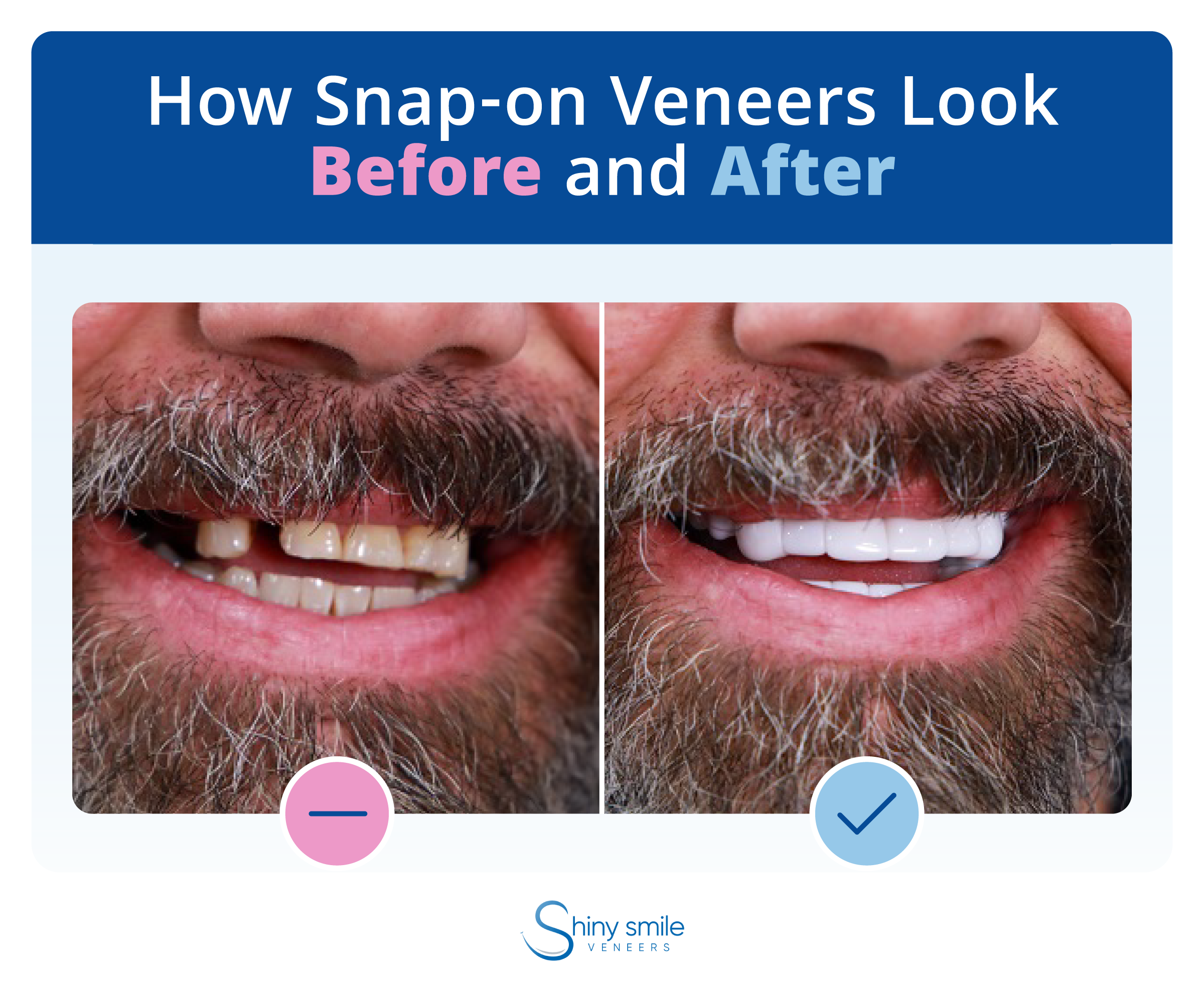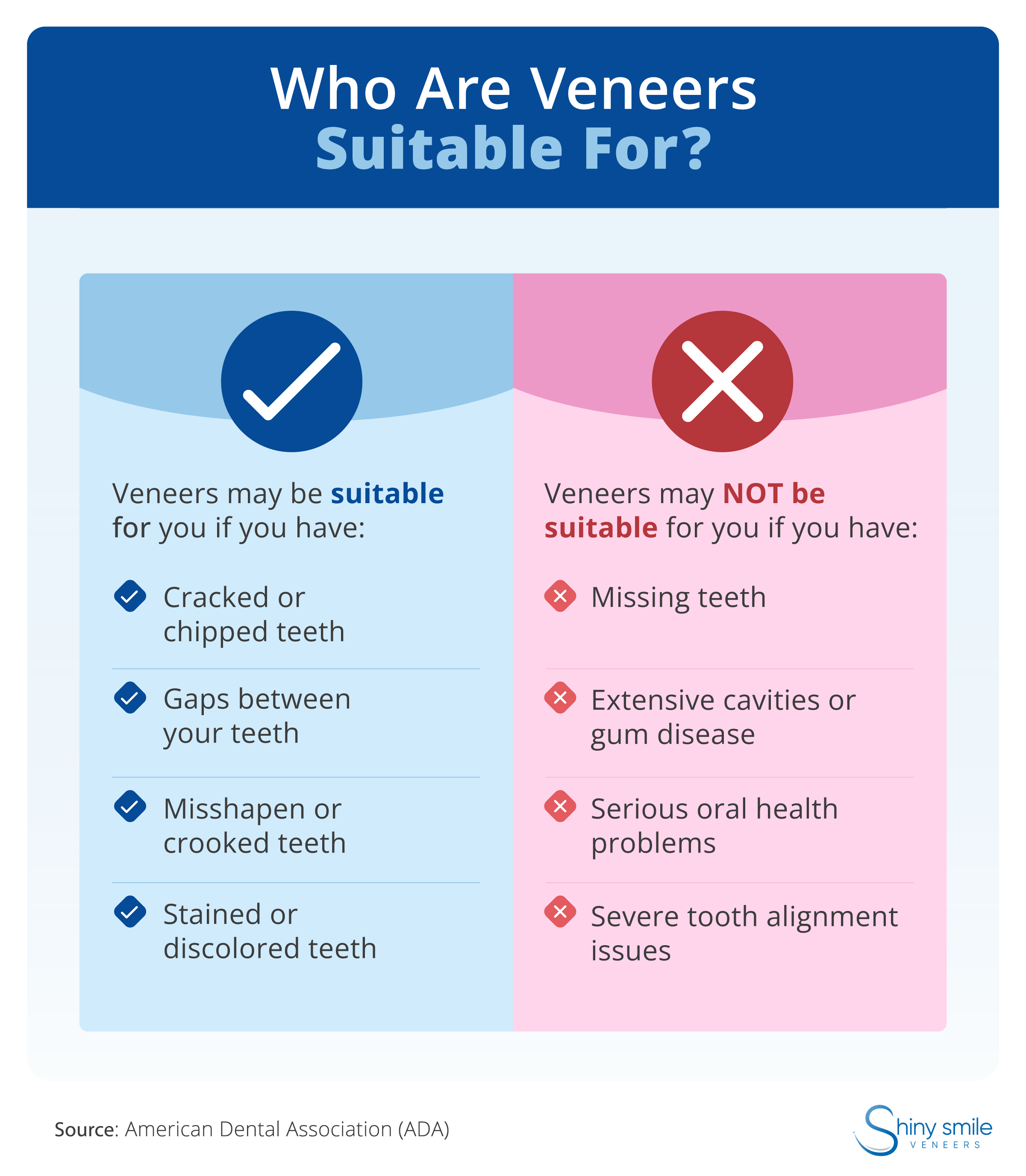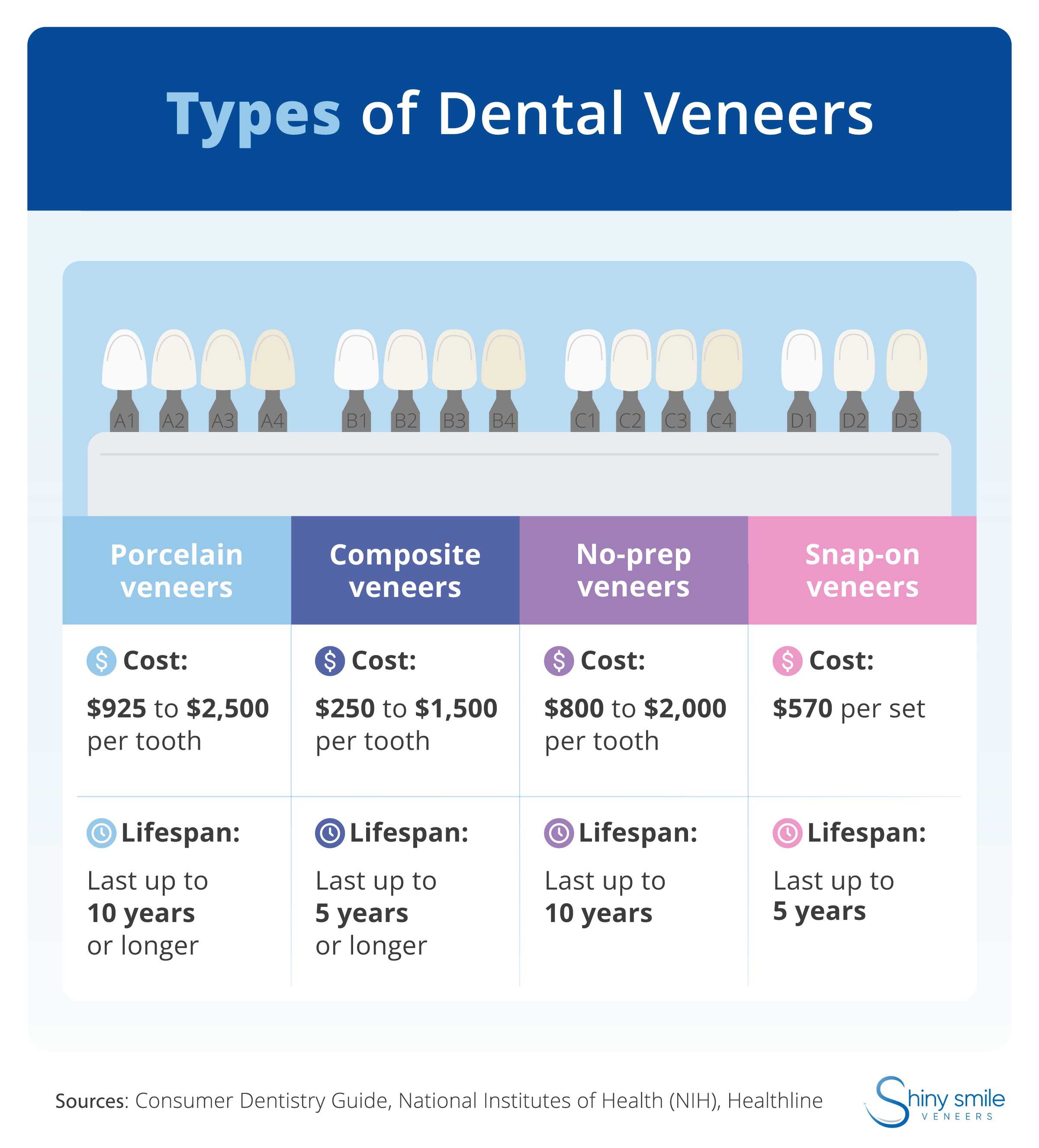Dental veneers are thin shells bonded to the front of your teeth that are made of tooth-colored materials like porcelain or composite resin. They help improve your smile by correcting the appearance of stained, chipped, decayed, or crooked teeth. In this post, we describe in detail the different types of dental veneers, how they are fitted, how much they cost, and how long they last.
What Are Dental Veneers?
Traditional veneers are thin shells attached to the front surface of your teeth, often made out of porcelain or resin. You can use veneers as a solution to conceal a single chipped tooth or to cover them all so that crooked or damaged teeth appear uniform.

Designed to improve the appearance of your smile, the veneer placement process is a cosmetic procedure that usually doesn’t require anesthesia. While traditional veneers won’t damage your teeth, the procedure is irreversible because it involves removing some of your natural tooth enamel. The veneers themselves, however, are not permanent and will eventually need to be replaced.
Other veneer options include semi-permanent “no-prep” veneers that can be bonded to your teeth without removing the enamel, as well as removable snap-on veneers that fit over your existing teeth. The right type of veneers for you depends on the nature of your dental issue, as well as your budget requirements and desired longevity of the treatment.

Who Are Veneers Suitable For?
Veneers may help improve your smile if you have damaged or broken teeth, teeth that are misshapen or crooked, teeth that have gaps between them, or teeth with stains or discoloration. Dental veneers look like natural teeth and come in various shapes and sizes to suit your mouth. If you’re looking to permanently whiten your teeth, porcelain veneers may make a good option because they are stain-resistant.
Who Are Veneers Not Suitable For?
Dental veneers can improve the overall appearance of your teeth, but they cannot treat severe dental issues. Because they can only be fitted to existing teeth, veneers may not be the right option for you if you have any missing teeth. Dental implants, which replace missing teeth with a surgical procedure, could be a better solution.

Likewise, veneers aren’t suitable for anyone with extensive cavities or gum disease. If you have serious oral health issues, you need to address those first before getting cosmetic procedures. Finally, veneers can’t replace orthodontic treatment for treating the alignment of your teeth, so your dentist may refer you to an orthodontist instead of suggesting veneers.
What Are the Different Types of Veneers?
Veneers vary by the material and preparation process used, whether the procedure is permanent, and how long the treatment lasts. In general, insurance won’t cover any type of dental veneer because the procedure is considered cosmetic dentistry.

Porcelain Veneers
Traditional porcelain veneers offer the most natural aesthetic because porcelain is translucent like real tooth enamel. This kind of dental veneer is also the most durable because porcelain is resistant to chipping and staining. Getting porcelain veneers requires a bit of treatment planning, as it involves two to three visits to a dentist over approximately six weeks.
The most long-lasting veneer type, porcelain veneers typically have a lifespan of up to ten years or longer (some studies show they may last up to 20 years). Also considered expensive, porcelain veneers cost between $925 and $2,500 per tooth. In addition, because they cannot be repaired, you may incur future replacement costs if your veneers are damaged.
Composite Resin Veneers
Composite resin veneers are a less invasive and often cheaper alternative to porcelain, but they are also less durable and can be more susceptible to staining. This type of veneer uses a tooth-shaded resin that can usually be applied to your teeth in a one-day treatment. As composite veneers may require less enamel to be removed from your teeth, your dentist can remove and replace the composite material if needed.
Getting composite veneers is usually a same-day procedure because the veneers can be fabricated while you wait. Composite veneers have a shorter lifespan than porcelain, typically lasting up to five years or possibly longer. They also often cost about half the price of porcelain veneers, usually ranging between $250 and $1,500 per tooth.
No-Prep Veneers
No-prep veneers often refer to several brands of semi-permanent veneers, typically made of porcelain, which are bonded to your teeth without removing the enamel. Unlike porcelain, these types of veneers can usually be created and fitted on the same day. Common brands of no-prep veneers included Vivaneers, Lumineers, and DURAthin.
Although no-prep veneers are considered reversible, they are applied over the enamel of your teeth so your teeth could still be damaged or otherwise affected by removing them.
The price and longevity of no-prep veneers depend on the brand. The manufacturers of Lumineers claim they last up to 20 years, but other sources report that they only last up to 10 years. Lumineers usually cost between $800 and $2,000 per tooth.
Snap-On veneers
Snap-on veneers fit over your existing teeth like a mouthguard, so they’re actually reversible and removable. Unlike traditional veneers, clip-on veneers won’t damage your teeth and don’t require the removal of any enamel or the use of adhesives like dental cement. You can fit them at home using a kit, so you don’t have to go to a dentist or risk any discomfort.
With Shiny Smile snap-on veneers, you can create the impression at home and then receive your customized veneers two to five weeks later (depending on the shipping option you choose). Most removable veneers are cheaper than traditional permanent veneers, with Shiny Smile veneers costing $570. Clip-on veneers last one to five years on average, and potentially longer depending on how often you wear them. Experts consistently rank Shiny Smile veneers as the best snap-on veneers available.
What Is the Procedure for Getting Permanent Veneers?
The process of getting traditional permanent veneers can often be completed in two to three visits to your dentist. The exact number of visits and total length of time for the dental procedures depends on which type of veneer material you choose.
1. Consult with your dentist
The first step to getting dental veneers involves scheduling a consultation with your dentist. During the visit, they will evaluate your oral health and whether you’re a candidate for veneers, decide which kind of veneers are most suitable, and discuss alternatives like teeth whitening or orthodontics. They may also take X-rays of your teeth. If you decide to go ahead with the veneer procedure, you will discuss your preferences for the shape, length, width, and color of the veneers so you can create the smile that you want.
2. Prepare your teeth
At your next visit, the dentist will give you a local anesthetic and prepare your teeth by removing a thin layer of enamel and reshaping them. If you’ve chosen porcelain veneers, the dentist will need to make an impression of your teeth in order to make a mold of your mouth. The mold is then sent to a dental lab to create the veneers. As this takes two to four weeks, your dentist will give you temporary veneers to wear in the meantime. If you’ve chosen composite resin veneers, the veneer placement process can take place during the same visit as when the enamel is removed.
3. Bond the veneers
If you’re getting composite veneers, the dentist will typically apply the resin directly to the tooth surface, shape it, harden it with a special light, and then polish it. Your treatment will be complete after your second visit. If you had porcelain veneers made from a mold of your mouth, you’ll require a third appointment to bond them to your teeth. The dentist will fit them, trim them, and possibly adjust the color to make sure they look right in your mouth.
What Is the Procedure for Getting Non-Permanent Veneers?
If you’ve chosen non-permanent veneers such as snap-ons, the procedure is less invasive and doesn’t require a visit to the dentist. For example, Shiny Smile Veneers work like this:
- Choose a shade for the veneers and order an impression kit online.
- Make impressions of your teeth at home and take photos of them.
- Send the kit back so that the veneers can be created according to the impressions.
- Receive customized snap-on veneers in the mail two to five weeks later.
How Do You Care for Veneers?
Veneers don’t require any additional maintenance, but to help them last as long as possible, you should take care not to damage them. Remember that porcelain veneers can’t be repaired, so they’ll need to be replaced if damaged. The following dental care practices can help you keep your veneers in good condition:
- Maintain good oral hygiene by flossing and brushing as you normally would with a non-abrasive fluoride toothpaste.
- See your dentist twice a year for regular check-ups and cleanings.
- Be careful when chewing hard foods like carrots (and things like nut shells or bones) and avoid using your teeth as a tool to open packages or tear off tags.
- Wear a protective appliance while sleeping if you have a tendency to grind your teeth.
- Brush or rinse your mouth after consuming red wine, coffee, tea, or soda to avoid staining.
Snap-On Veneers Can Help Restore Your Smile
Veneers are a cosmetic procedure that can help conceal aesthetic imperfections in your smile. They are permanently bonded to your teeth and can enhance your smile
You can choose from several different types made of different materials that require different applications. To decide which is right for you, consider your budget and how often you would need to replace the veneers.
If you’re seeking a less costly option or want to avoid an irreversible dental procedure that removes your tooth enamel, snap-on Shiny Smile Veneers may be the ideal solution to restore confidence in your smile.
